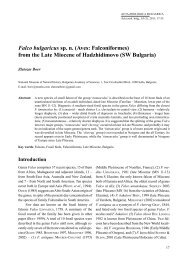Gyps bochenskii sp. n. (Aves: Falconiformes) from the Late ... - ecodb
Gyps bochenskii sp. n. (Aves: Falconiformes) from the Late ... - ecodb
Gyps bochenskii sp. n. (Aves: Falconiformes) from the Late ... - ecodb
Create successful ePaper yourself
Turn your PDF publications into a flip-book with our unique Google optimized e-Paper software.
<strong>Gyps</strong> <strong>bochenskii</strong> <strong>sp</strong>. n. (<strong>Aves</strong>: <strong>Falconiformes</strong>) <strong>from</strong> <strong>the</strong> <strong>Late</strong>....<br />
Fig. 4. Manner of measuring <strong>the</strong> bones: A – sternum, pars coracoidalis; B – sternum, pars costalis; C – coracoid, pars<br />
humeralis; D – coracoid, pars sternalis; E – phalanx dist. dig. majoris sin., F – phalanx dist. dig. I pedis sin. (Drawings:<br />
VERA HRISTOVA).<br />
of linea intermuscularis, relatively thicker incisurae<br />
intercostales (measurements ‘c’, ‘e’ and ‘g’), and <strong>the</strong><br />
relatively longer incisura intercostalis IV (correlation<br />
between <strong>the</strong> measurements ‘j’ and ‘i’); (3) coracoid<br />
– by its larger proc. acrocoracoideus (measurement<br />
‘c’), and more protuberant, than flattened f. a.<br />
clavicularis in ventral view (Fig. 1, 2); (4) phalanx<br />
dist. dig. majoris sin. – by <strong>the</strong> thicker body of<br />
phalanx e<strong>sp</strong>ecially before its articular part, deeper<br />
fossa on lateral tip of <strong>the</strong> f.a., and <strong>the</strong> less concave<br />
medial edge of f.a.; (5) phalanx dist. dig. I pedis sin.<br />
– by <strong>the</strong> longer (thicker) base (measurement ‘d’) and<br />
<strong>the</strong> higher f.a. (measurement ‘b’). Differences <strong>from</strong><br />
Pleistocene G. melitensis: better developed hind<br />
limbs (about 1/10 in <strong>the</strong> measurements of distal pedal<br />
phalanges) and <strong>the</strong> same development of wings<br />
(phalanx dist. dig. majoris).<br />
Locality: A ponor in a rocky hill, 6 km NNE<br />
of <strong>the</strong> town of Varshets (43, 13 N, 23, 17 E).<br />
Unconsolidated, unstratified sediments accumulated<br />
as a clay terra-rossa. The fossil bones are broken, at<br />
times forming a bone breccia.<br />
Chronology: Middle Villafranchian. The associated<br />
mammal fauna (SPASSOV 1997 a, b, 2000;<br />
POPOV 2001) gives <strong>the</strong> site an MN 17 zone attribution<br />
(MEIN 1990).<br />
Comparison and Discussion<br />
The <strong>sp</strong>ecimens show all <strong>the</strong> features characteristic<br />
of <strong>the</strong> largest accipitrids. However, <strong>the</strong> sternum<br />
clearly differs <strong>from</strong> Aquilinae <strong>sp</strong>ecies by asymmetrical<br />
manubrium sterni in cranial view and overlaping<br />
of <strong>the</strong> left over right s. a. coracoideus (Haliaeetus<br />
pelagicus BMNH 1996.31.1, Aquila chrysaetos<br />
BMNH 1930.3.24.260, and Harpia harpyja BMNH<br />
1862.3.19.14 have been compared). In general <strong>the</strong><br />
size of eagles is smaller than that of griffon vultures,<br />
and f.a. clavicularis in griffon vultures is relatively<br />
wider (measurement ‘c’) (Table 4). The bones<br />
strongly resemble Gypaetinae subfamily both in<br />
morphology and dimensions. Detailed comparison<br />
entirely excludes all o<strong>the</strong>r genera, except <strong>Gyps</strong>. As<br />
reported by CRAMP (1980) <strong>the</strong> sexual dimorphism<br />
in size, involves females that are on ‘average larger<br />
than males’ (p. 63) in Palearctic vultures. In <strong>the</strong> clos-<br />
221





